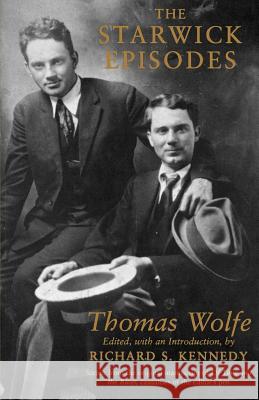The Starwick Episodes » książka
The Starwick Episodes
ISBN-13: 9780807119754 / Angielski / Miękka / 1994 / 124 str.
One of the most enduring characters in Thomas Wolfe's fiction is Francis Starwick, the Midwestern aesthete who befriends Eugene Grant at Harvard in Wolfe's second autobiographical novel, Of Time and the River. Wolfe created Starwick in order to provide a foil for the artistic development of Eugene: Starwick was the pretentious, narrow-minded dilettante whose response to the arts is all talk and pose, as compared with Eugene, who hopes to express in writing his intensity of feeling about all aspects of life
While writing the novel, however, Wolfe found his manuscript proliferating beyond his control, and he turned to his editor at Scribner's Maxwell Perkins, for help in shaping the final version of the book. In the process of organizing the massive manuscript for publication, Perkins deleted some of the analyses of Starwick's behavior and several of the episodes involving Eugene and Starwick. The result was that the relationship between the two young men was not as fully developed as Wolfe had originally planned.
Richard S. Kennedy discovered these excised passages among the Wolfe papers at Harvard University's Houghton Library. In The Starwick Episodes has arranged them sequentially and indicated their position in the original manuscript. IN one of them Starwick introduces Eugene to Joyce's Ulysses, and in another he takes him to view the paintings in Boston' Museum of Fine Arts. Additional scenes find the two exploring the lower depts. Of Paris until at length their true sexual natures are revealed in a visit to a Parisian brothel.
Kennedy's research also uncovered the story of the life of Kenneth Raisbeck, the young man whom Wolfe used as the starting point for his fictional creation of Starwick. In his Introduction, Kennedy describes Raisbeck's career, both its brilliant promise and its tragic end, and his similarity to the character in the novel.
The presence of Starwick in Of Time and the River is unforgettable despite the omission of some important scenes that Wolfe wrote for him. With the publication now of the deleted episodes, readers may gain an enriched sense of Wolfe's fascinating creation and a fuller understanding of what he was trying to convey.
One of the most enduring characters in Thomas Wolfes fiction is Francis Starwick, the midwestern aesthete who befriends Eugene Gant at Harvard in Wolfes second autobiographical novel, Of Time and the River. In the process of organizing Wolfes massive manuscript for publication, however, editor Maxwell Perkins deleted some of the analyses of Starwicks behavior and several of the episodes involving Eugene and Starwick. The result was that the relationship between the two young men was not as fully developed as Wolfe had originally planned. Richard S. Kennedy discovered these excised passages among the Wolfe papers at Harvard Universitys Houghton Library. In The Starwick Episodes he has arranged them sequentially and indicated their position in the original manuscript. In one of them Starwick introduces Eugene to Joyces Ulysses, and in another he takes him to view the paintings in Bostons Museum of Fine arts. Additional scenes find the two exploring the lower depths of Paris until at length their true sexual natures are revealed in a visit to a Parsian brothel. Kennedys research also uncovered the story of the life of Kenneth Raisbeck, the young man whom Wolfe used as the starting point for his fictional creation of Starwick. In his Introduction, Kennedy describes Raisbecks career, both its brilliant promise and its tragic end, and his similarity to the character in the novel.











